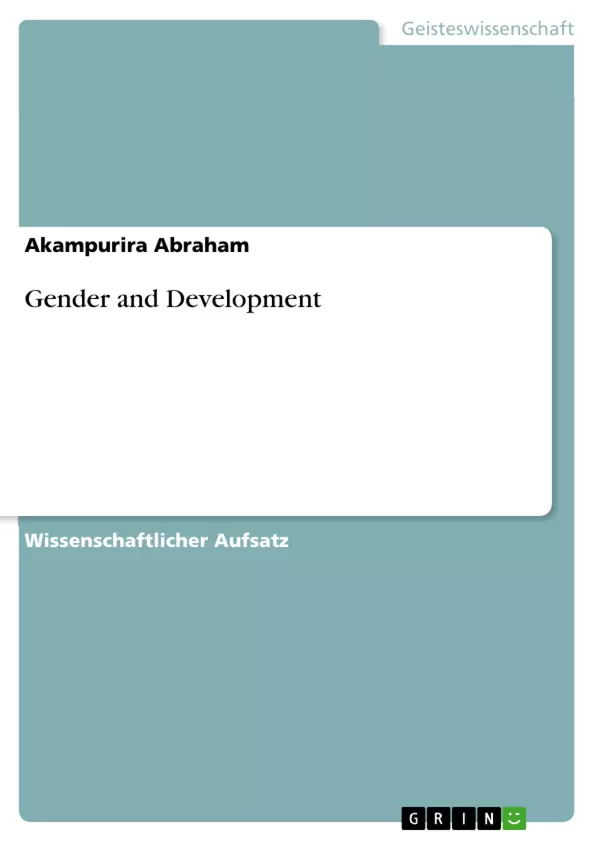Gender and development continues to be one of the major concerns of our time. It requires respective governments and community leaders to embrace gender and development for the good of our communities. Women have generally been put aside in the areas of planning, allocation of resources and decision making which have deprived society of a potential human capital.
Ever since historical times, men and women have not walked at the same strides. This is evidenced in the areas of commerce, politics, social and economic spheres. They have not lived in the required harmony, yet they are meant to live beside each other to achieve the best out of the natural resources. They should play a complementally role of combining other factors of production for their own benefit. Men have however taken a lead in arenas that benefit him and left what he feels is invariably of less value to the woman. Society has put man in an advantaged position that creates his superiority over the woman through their roles and responsibilities they perform.
Inhaltsverzeichnis
- 1.0 Introduction
- 2.0 Description
- 2.1 Similarities between males & females
- 2.2 Gender Stereo Types
- 2.3 What men think about men
- 2.4 What men think about women
- 2.5 What women think of men
- 2.6 What women think about women
- 3.0 Gender roles and responsibilities
- 3.1 Reproductive roles
- 3.2 Productive roles
- 3.3 Patriarchy
- 3.3.1 What is patriarchy?
- 3.3.2 Is patriacrchy the same everywhere?
- 3.3.3 What men control in patriarchy system
- 3.3.4 Educational and knowledge systems
- 3.3.4.1 Primary Enrolment by gender and age
- 3.3.4.2 Are women completely powerless in the patriarchial societies?
- 3.3.4.3 Do all men benefit from patriarchial
- 3.4 Why is gender a development issue?
- 3.5 Feminism
- 3.6 Gender violence
- 3.7 Gender discrimination
- 3.8 Gender division of labour
- 4.0 General recommendations
- 5.0 Conclusion
Zielsetzung und Themenschwerpunkte
Diese Arbeit befasst sich mit dem Thema Gender und Entwicklung und untersucht dessen Bedeutung in verschiedenen Lebensbereichen. Sie erforscht die sozialen und kulturellen Konstruktionen von Geschlecht und die daraus resultierenden Machtverhältnisse zwischen Männern und Frauen. Das Ziel ist es, die Herausforderungen und Chancen von Gendergerechtigkeit im Kontext der Entwicklung zu beleuchten.
- Soziale Konstruktion von Geschlecht
- Geschlechterrollen und -verantwortung
- Patriarchale Strukturen und deren Auswirkungen
- Gendergerechtigkeit als Entwicklungsziel
- Die Rolle von Bildung und Wissen im Kontext von Gender
Zusammenfassung der Kapitel
Das erste Kapitel beleuchtet die Bedeutung von Gender und Entwicklung und stellt den Kontext der Arbeit dar. Es wird auf die unterschiedlichen Lebenserfahrungen von Männern und Frauen eingegangen sowie auf die geschlechtsspezifischen Herausforderungen in verschiedenen Bereichen. Im zweiten Kapitel werden die Begriffe Geschlecht und Gender definiert und die sozialen und biologischen Aspekte des Geschlechts betrachtet. Das dritte Kapitel analysiert die unterschiedlichen Geschlechterrollen und -verantwortlichkeiten in verschiedenen Bereichen der Gesellschaft. Es wird auf die Auswirkungen von patriarchalen Strukturen und deren Einfluss auf die Lebensbedingungen von Frauen und Männern eingegangen.
Schlüsselwörter
Die Arbeit konzentriert sich auf die Themen Gender, Entwicklung, Geschlechterrollen, Patriarchat, Bildung, soziale Konstruktion von Geschlecht und Gendergerechtigkeit. Sie beleuchtet die Auswirkungen von Geschlechterungleichheit auf verschiedene Lebensbereiche und betont die Bedeutung von Gleichberechtigung und Empowerment für die nachhaltige Entwicklung.
- Arbeit zitieren
- DOCTOR Akampurira Abraham (Autor:in), 2011, Gender and Development, München, GRIN Verlag, https://www.grin.com/document/207912



